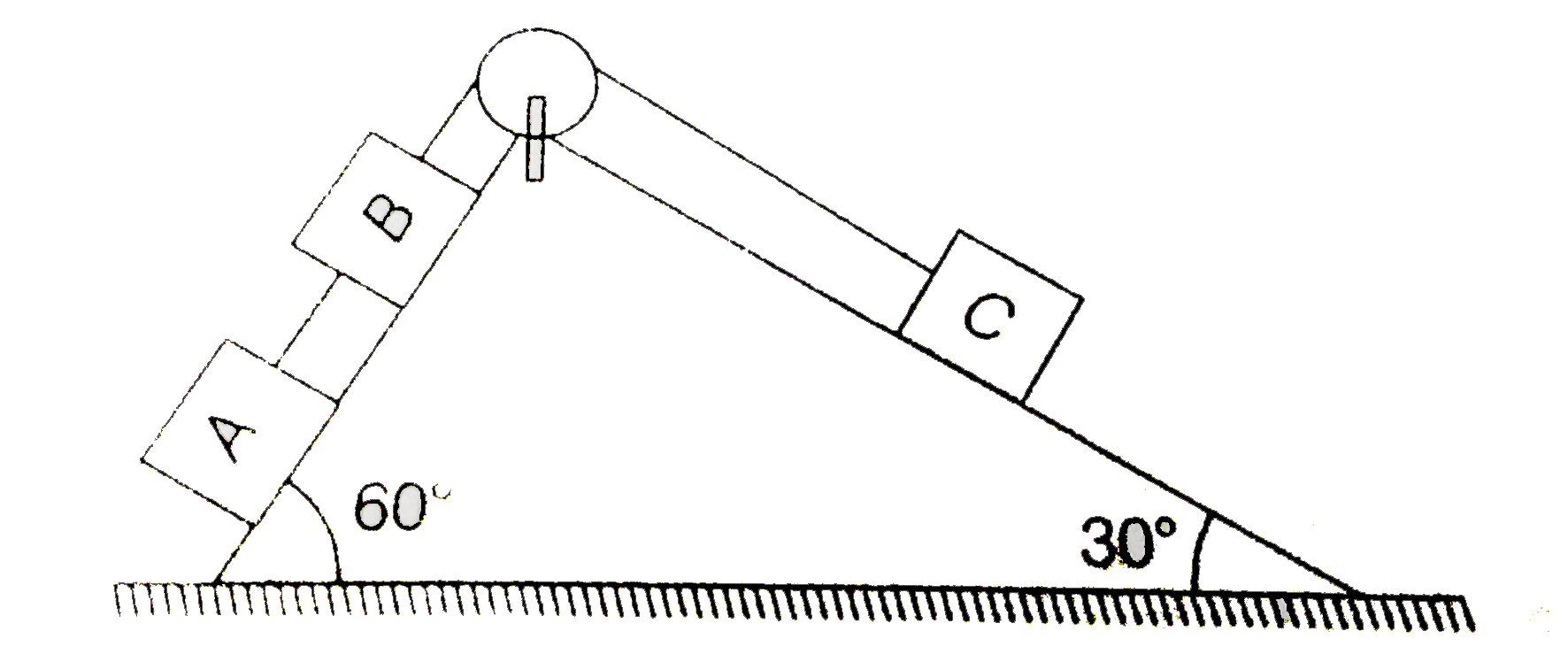Shown in the figure is a system of three particles of mass 1kg,2kg and 4kg connected by two springs. The acceleration of A.B and C at any instant are 1ms−2,2ms−2 and 1/2ms−2 respectively directed as shown in the figure external force acting on the system is
1N
7N
3N
none of these
The correct Answer is:C
To solve the problem, we need to find the external force acting on a system of three particles connected by springs. The given masses and their respective accelerations are as follows:
- Mass mA=1kg with acceleration aA=1m/s2
- Mass mB=2kg with acceleration aB=2m/s2
- Mass mC=4kg with acceleration aC=0.5m/s2
1. Calculate the Total Mass of the System:
mtotal=mA+mB+mC=1kg+2kg+4kg=7kg
2. Calculate the Center of Mass Acceleration:
The acceleration of the center of mass acm can be calculated using the formula:
acm=mA⋅aA+mB⋅aB+mC⋅aCmtotal
Substituting the values:
acm=(1kg⋅1m/s2)+(2kg⋅2m/s2)+(4kg⋅0.5m/s2)7kg
=1+4+27=77=1m/s2
3. Calculate the External Force Acting on the System:
According to Newton's second law, the external force Fexternal can be calculated as:
Fexternal=mtotal⋅acm
Substituting the values:
Fexternal=7kg⋅1m/s2=7N
Final Answer:
The external force acting on the system is 7N.
---
- Mass mB=2kg with acceleration aB=2m/s2
- Mass mC=4kg with acceleration aC=0.5m/s2
mtotal=mA+mB+mC=1kg+2kg+4kg=7kg
The acceleration of the center of mass acm can be calculated using the formula:
acm=mA⋅aA+mB⋅aB+mC⋅aCmtotal
Substituting the values:
acm=(1kg⋅1m/s2)+(2kg⋅2m/s2)+(4kg⋅0.5m/s2)7kg
=1+4+27=77=1m/s2
According to Newton's second law, the external force Fexternal can be calculated as:
Fexternal=mtotal⋅acm
Substituting the values:
Fexternal=7kg⋅1m/s2=7N
The external force acting on the system is 7N.
Topper's Solved these Questions
- CENTRE OF MASSBOOK - CENGAGE PHYSICS ENGLISHCHAPTER - CENTRE OF MASSEXERCISE - Multiple Correct
25 Videos
- CENTRE OF MASSBOOK - CENGAGE PHYSICS ENGLISHCHAPTER - CENTRE OF MASSEXERCISE - Assertion - Reasoning
2 Videos
- CENTRE OF MASSBOOK - CENGAGE PHYSICS ENGLISHCHAPTER - CENTRE OF MASSEXERCISE - Subjective
23 Videos
- CALORIMETRYBOOK - CENGAGE PHYSICS ENGLISHCHAPTER - CALORIMETRYEXERCISE - Solved Example
13 Videos
- DIMENSIONS & MEASUREMENTBOOK - CENGAGE PHYSICS ENGLISHCHAPTER - DIMENSIONS & MEASUREMENTEXERCISE - Integer
2 Videos
Similar Questions
Three small balls of masses 1kg, 2kg and 3kg are moving in a plane and their velocities are 1ms−1,2ms−2and3ms−1 respectively as shown . The total angular momentum of the system of three balls about point P at the given instant of time is

View SolutionThree particles of masses 1kg,2kg and 3kg are situated at the corners of an equilateral triangle move at speed 6ms−1,3ms−1 and 2ms−1 respectively. Each particle maintains a direction towards the particles at the next corners symmetrically. Find velocity of CM of the system at this instant

View Solution
Knowledge Check
In the system shown in the figure, the acceleration of 1 kg mass is
 Ag4downwardsBg2downwardsCg2upwardsDg4upwards
Ag4downwardsBg2downwardsCg2upwardsDg4upwards
Two particles of masses 2 kg and 4 kg are approaching each other with acceleration 1ms−2 and 2ms−2, respectively, on a smooth horizontal surface. Find the acceleration of center of mass of the system.
View SolutionTwo particles are thrown simultaneously from points A and B with velocities u1=2ms−1andu2−14ms−1, respectively, as shown in figure.

Minimum separation between A and B is
View SolutionTwo particles are thrown simultaneously from points A and B with velocities u1=2ms−1andu2−14ms−1, respectively, as shown in figure.

The relative velocity of B as seen from A in
View SolutionIn the adjacent figure, mass of A, B and C are 1 kg , 3 kg and 2 kg, respectively. Find

(a) the acceleration of the system, and
(b) tensions in the string .
Neglect friction. (g=10ms−2)
View SolutionIn the adjacent figure, mass of A, B and C are 1 kg , 3 kg and 2 kg, respectively. Find

(a) the acceleration of the system, and
(b) tensions in the string .
Neglect friction. (g=10ms−2)
View SolutionIn the adjacent figure, mass of A, B and C are 1 kg , 3 kg and 2 kg, respectively. Find

(a) the acceleration of the system, and
(b) tensions in the string .
Neglect friction. (g=10ms−2)
View SolutionA 20kg blocks is placed on of 50kgblock as shown in figure An horizontal force F acting on A causes an acceleration of 3ms−2 to A and 2ms−2 to B as shown in the figure for this situation mark out the corect statement(s)

View Solution
